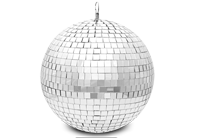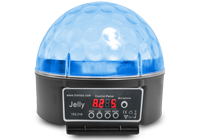What's the difference between a disco ball and a mirror ball? It's a question that many have since asked. For both of these lighting effects, there are pros and cons between them both. Here we will explain the specific effects of each device and more importantly how they can be used best in a venue setting.
Buy Disco Ball Lights
Rotating lights are an excellent centrepiece to any celebration when the lights turn into many multiple rays of revolving colour. These systems just need plugging in and switching on, with most light-up disco balls having their own remote control too so you can operate the colours and speeds from a distance. The most noticeable difference between disco and mirror balls is the intensity of the effect which we will cover in the next section.
You’ll notice with mirror balls they are often hung up in the centre of a room, allowing lights to be refracted in every direction. Sometimes though this bounces bright beams of light into the eyes of audiences, their disco counterparts still provide a lot of light but have a much more diffused light effect. This makes the item a slightly more comfortable option for the guests at your party or the audience to your performances.
Mirror balls are attached to a small motor hung on the ceiling which revolves around the ball itself, there is no other electrical element to them. Lights are then directed toward the ball itself, which is totally covered in hundreds of tessellated pieces of reflective material. This method spreads your light effect all across the room in question, a technique that has been in use for decades.
Uses for light-up disco balls
We see a lot of working professionals using this lighting beneath their DJ booths, the DJ booths can be covered in stretchy white lycra or similar material. This translucent cover allows the light effects created by the ball to still be visible, producing an interesting effect that stands out in a crowd. More often than not we see the balls placed right beside DJs to direct the audience's focus to the DJ themselves. Light up disco balls are also an excellent inclusion to any party preparation as they are a quick solution to most poorly lit situations.
They have been a nightlife mainstay for a fairly long time at this stage but we are often seeing these systems used as part of modern home decor. An unanticipated home design trend that claims decorative disco and mirror balls give off the impression that the residents don’t take life too seriously. We even see them used as a quick solution to Christmas decorations, covering the room in lights as opposed to fairy lights, wreaths and other festive items.
On the other hand, mirror balls are now used prominently at weddings with couples holding them in photoshoots, hanging above the altar or even the main dining tables. Many like to hang mirror balls of varying sizes together for a more striking effect or even place a bunch as decoration for the aisles. They also look exceptional when placed inside a tented or marquee based wedding venue, with this much light all around the venue, your pictures will look stunning.
How to place a disco ball correctly?
The electronic aspect of the disco ball light systems limits them to stay near a power source, so are best kept indoors in case of poor weather. The placement of the ball is important, some use them in corners of rooms to highlight where corners are but usually, they are a centrepiece item. Whether they are on a stand or mounted to the ceiling, the best option is to let them rotate and let them deliver their full intended effect.
The placement of your ball is important, but coupling the lighting with a smoke effect of some kind is highly advised. Smoke effects such as haze and fog will make any beams of light created far more visible, a method used by venue staff and pro DJs for decades. Whether you are using a disco or mirror ball you can get even better results by considering a smoke effect.
Where the beams of light still pierce through the smoke, the smoke will highlight the entire length of the light. However, where the balls themselves will be revolving, the smoke embellished beams of light will follow suit providing an amazing lighting effect. If you would prefer light effects beside you, it will always look a lot more cohesive if you have a pair of lighting fixtures at either side of you.
Origins of this light effect
Originally the mirror ball was patented in 1917 and went by the name of a Myriad Reflector, which makes sense due to its multiple instances of light created. Although it took a good fifty years for them to hit their heyday in the 1970s when they became known for their effects during the Motown/disco musical era. Ever since this time the mirror ball has experienced peaks and troughs in popularity, going through a resurgence in the early '00s and is now back again twenty years later.
Disco and mirror balls are popular all year round, but as people get ready for their end of year work parties we see a large rise in orders. This goes to show that people still view these items to be synonymous with celebrations, partying or just generally having fun. There are many choices around this type of item but be sure to order some extras to go with your ball.
This is testament to the global appeal of items like this, of course, the idea has been expanded upon with a more modern touch. Nevertheless, the original myriad reflector model is still hugely sought after and remains globally popular an entire century after conception. The balls that contain their own light source have become just as fashionable and can be used with equal simplicity.







